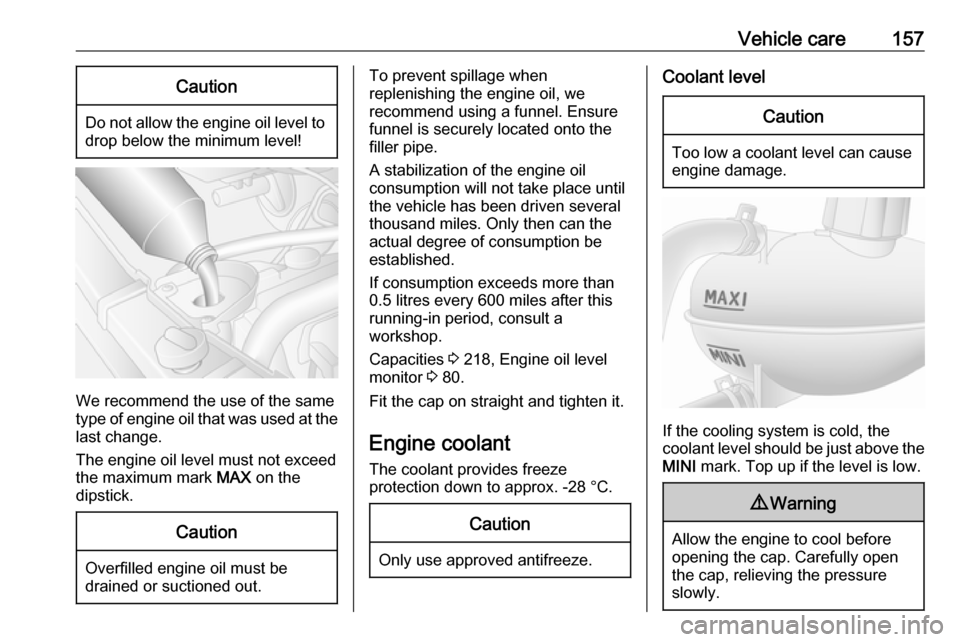2016 VAUXHALL MOVANO_B engine coolant
[x] Cancel search: engine coolantPage 156 of 233

154Vehicle careGeneral Information
Accessories and vehicle modifications
We recommend the use of genuine
parts and accessories and factory
approved parts specific for your
vehicle type. We cannot assess or guarantee reliability of other products
- even if they have a regulatory or
otherwise granted approval.
Do not make any modifications to the electrical system, e.g. changes of
electronic control units (chip tuning).Caution
When transporting the vehicle on
a train or on a recovery vehicle, the
mud flaps might be damaged.
Vehicle storage
Storage for a long period of time
If the vehicle is to be stored for several months:
● Wash and wax the vehicle.
● Have the wax in the engine compartment and underbody
checked.
● Clean and preserve rubber seals.
● Change engine oil.
● Drain washer fluid reservoir. ● Check coolant antifreeze and corrosion protection.
● Adjust tyre pressure to the value specified for full load.
● Park vehicle in a dry, well ventilated place. Engage first or
reverse gear. Prevent the vehicle
from rolling.
● Do not apply parking brake.● Open bonnet, close all doors and
lock the vehicle.
● Disconnect the clamp from the negative terminal of the vehicle
battery. Beware that all systems
are not functional, e.g. anti-theft
alarm system.
Putting back into operation When the vehicle is to be put back into
operation:
● Connect the clamp to the negative terminal of the vehicle
battery. Activate the electronics
of the power windows.
● Check tyre pressure.
● Fill up the washer fluid reservoir. ● Check the engine oil level.
● Check the coolant level.
● Fit the number plate, if necessary.
Page 157 of 233

Vehicle care155End-of-life vehicle recovery
Information on end-of-life vehicle
recovery centres and the recycling of
end-of-life vehicles is available on our website, where legally required. Only
entrust this work to an authorised
recycling centre.Vehicle checks
Performing work9 Warning
Only perform engine compartment
checks when the ignition is off.
The cooling fan may start
operating even if the ignition is off.
9 Danger
The ignition system generates
extremely high voltages. Do not
touch.
The caps for topping up the engine oil, the coolant, the washer fluid and the
oil dipstick handle are yellow for ease
of identification.
Bonnet
Opening
Pull the release lever and return it to
its original position.
Page 159 of 233

Vehicle care157Caution
Do not allow the engine oil level todrop below the minimum level!
We recommend the use of the same
type of engine oil that was used at the
last change.
The engine oil level must not exceed the maximum mark MAX on the
dipstick.
Caution
Overfilled engine oil must be
drained or suctioned out.
To prevent spillage when
replenishing the engine oil, we
recommend using a funnel. Ensure funnel is securely located onto the
filler pipe.
A stabilization of the engine oil
consumption will not take place until
the vehicle has been driven several
thousand miles. Only then can the
actual degree of consumption be
established.
If consumption exceeds more than
0.5 litres every 600 miles after this
running-in period, consult a
workshop.
Capacities 3 218, Engine oil level
monitor 3 80.
Fit the cap on straight and tighten it.
Engine coolant The coolant provides freeze
protection down to approx. -28 °C.Caution
Only use approved antifreeze.
Coolant levelCaution
Too low a coolant level can cause engine damage.
If the cooling system is cold, the
coolant level should be just above the
MINI mark. Top up if the level is low.
9Warning
Allow the engine to cool before
opening the cap. Carefully open
the cap, relieving the pressure
slowly.
Page 160 of 233

158Vehicle careTop up with antifreeze. If no
antifreeze is available, use clean tap
water or distilled water. Install the cap tightly. Have the antifreeze
concentration checked and have the cause of the coolant loss remedied by
a workshop.
If a substantial amount of coolant is
required, it will be necessary to bleed any trapped air from the cooling
system. Seek the assistance of a
workshop.
Power steering fluidCaution
Extremely small amounts of
contamination can cause steering
system damage and cause it to not work properly. Do not allow
contaminates to contact the fluid
side of the reservoir cap or from
entering the reservoir.
The fluid level normally does not need
to be checked. If an unusual noise is
heard during steering or if the power
steering reacts conspicuously, seek
the assistance of a workshop.
Depending on vehicle, the power
steering fluid reservoir may be
located in the engine compartment
(Type A) or below the front wheel
arch, behind a trim panel (Type B).
Type A
If the fluid level in the reservoir falls
below the MINI mark, consult a
workshop.
Type B
If the fluid level in the reservoir falls
below the MIN mark, consult a
workshop.
Page 172 of 233

170Vehicle careElectrical systemFuses
Data on the replacement fuse must
match the data on the defective fuse.
There are two fuse boxes in the
vehicle:
● on the left-hand side of the instrument panel, behind the trimpanel
● in the engine compartment located below the coolant
expansion tankCombi
An additional fuse box is located
behind a trim panel on the right-hand
side of the load compartment, beside
the rear door.Bus
An additional fuse box is located on
the lower right-hand side of the load
compartment, below the step trim
panel.
Before replacing a fuse, turn off the
respective switch and the ignition.A blown fuse can be recognised by its melted wire. Do not replace the fuse
until the cause of the fault has been
remedied.
It is advisable to carry a full set of
fuses. Consult a workshop.
Some functions are protected by
several fuses.
Fuses may also be inserted without existence of a function.
Notice
Not all fuse box descriptions in this
manual may apply to your vehicle.
When inspecting the fuse box, refer
to the fuse box label.
Fuse extractor
Page 173 of 233

Vehicle care171
To help in replacing fuses, a fuse
extractor is located in the instrument
panel fuse box.
Place the fuse extractor on the
various types of fuse from the top or
side, and withdraw fuse.
Engine compartment fusebox
Located below the coolant expansion tank.
Some circuits may be protected by
several fuses.
Due to restricted accessibility, have
fuses replaced by a workshop.SymbolCircuitSRight side lightsTLeft side lightsWRight low beamaLeft low beam>Front fog lightLLeft high beamNRight high beamuABSKWindscreen wiperSymbolCircuitnHeating and ventilation
system / Air conditioningVHeated windscreen
Instrument panel fuse box
Located behind the trim panel on the
left-hand side of the instrument panel.
Pull upper part of trim panel to
remove.
Do not store any objects behind this
panel.
Some circuits may be protected by
several fuses.
Page 199 of 233

Service and maintenance197Additional engine oil additives
The use of additional engine oil
additives could cause damage and
invalidate the warranty.
Engine oil viscosity grades
The SAE viscosity grade gives
information of the thickness of the oil.
Multigrade oil is indicated by two
figures, e.g. SAE 5W-30. The first
figure, followed by a W, indicates the
low temperature viscosity and the
second figure the high temperature viscosity.
Select the appropriate viscosity grade depending on the minimum ambient
temperature 3 200.
All of the recommended viscosity
grades are suitable for high ambient
temperatures.
Coolant and antifreeze
Use only silicate-free long life coolant (LLC) antifreeze approved for thevehicle. Consult a workshop.
The system is factory filled with
coolant designed for excellent
corrosion protection and frost
protection down to approx. -28 °C.This concentration should be
maintained all year round. The use of additional coolant additives that
intend to give additional corrosion
protection or seal against minor leaks
can cause function problems. Liability
for consequences resulting from the
use of additional coolant additives will be rejected.
Brake fluid
Over time, brake fluid absorbs
moisture which will reduce braking
effectiveness. The brake fluid should therefore be replaced at the specified interval.
AdBlue Only use AdBlue to reduce the
nitrogen oxides in the exhaust
emission 3 125.
Page 227 of 233

225Cigarette lighter ........................... 77
Cleaning the vehicle ...................192
Climate control ............................. 15
Climate control systems .............103
Clock ............................................ 75
Control indicators.......................... 81
Control of the vehicle .................116
Controls ........................................ 73
Convex shape .............................. 33
Coolant ....................................... 157
Coolant and antifreeze ...............196
Coolant heater ............................ 109
Cornering light ......................98, 164
Coupling ball bar ........................151
Cruise control ...................... 89, 139
Cupholders .................................. 65
D Danger, Warnings and Cautions ...4
Dashboard .................................... 10
Daytime running lights .................97
Declaration of conformity ............221
DEF ............................................ 125
Demisting and defrosting ..............15
Diesel exhaust fluid ....................125
Diesel fuel ................................... 148
Diesel fuel filter .......................... 161
Diesel fuel system bleeding .......161
Diesel particle filter ....................124
Door locks..................................... 21Door open .................................... 89
Doors ............................................ 26
DPF (diesel particle filter) ...........124
Driver assistance systems ..........139
Driver Information Centre .............89
Driving characteristics and towing tips .............................. 150
Driving economically................... 116
Driving hints ................................ 116
E ECO mode .................................. 116
ecoScoring.................................... 92
Electric adjustment ......................33
Electrical system......................... 170
Electronic climate control system 105
Electronic driving programmes ..132
Electronic Stability Program 86,
137, 151
Electronic Stability Program off ...86
Emergency exit .......................36, 37
End-of-life vehicle recovery .......155
Engine compartment fuse box ...171
Engine coolant ........................... 157
Engine coolant temperature ........87
Engine coolant temperature gauge ....................................... 79
Engine data ............................... 201
Engine exhaust .......................... 124
Engine identification ...................199Engine oil ...........156, 196, 200, 218
Engine oil additives ....................196
Engine oil level monitor ................80
Engine oil pressure ......................87
Engine oil viscosity grades .........196
Enhanced Traction function 136, 137
Event data recorders ..................221
Exhaust gases ............................ 124
Exit lighting ................................ 101
Exterior care .............................. 192
Exterior light ................................. 88
Exterior lighting ......................12, 95
Exterior mirrors ............................. 33
F
Fault ........................................... 133
Fire extinguisher ........................... 70
First aid ......................................... 69
First aid kit ................................... 69
Fixed air vents ........................... 114
Fog light ....................................... 89
Fog lights .............................. 98, 165
Folding mirrors ............................. 33
Front airbag system .....................52
Front courtesy light .......................99
Front fog lights ........................ 95, 98
Front reading light....................... 100
Front seats.................................... 39
Front storage ................................ 65
Front turn signal lights ...............165